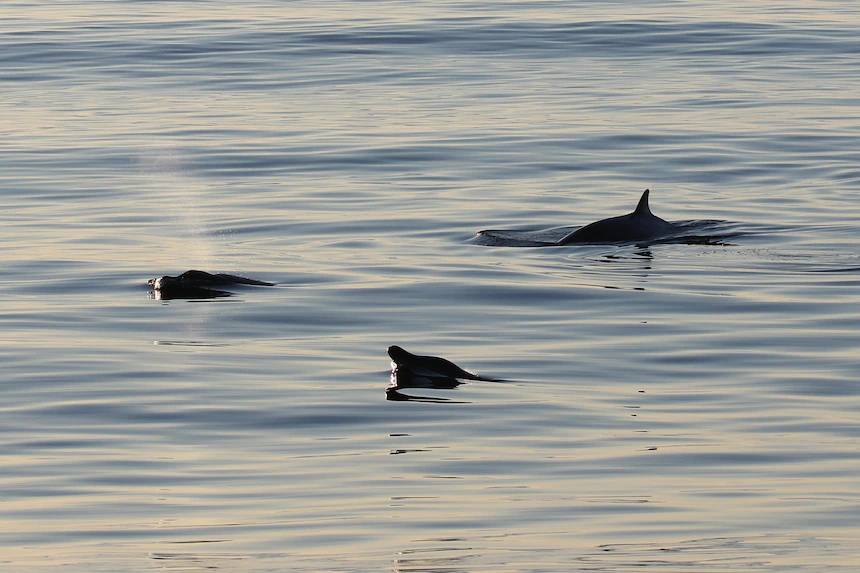Discovering a new species of animal is always huge news.
Who wouldn’t be excited about a brand-new animal, never before seen on earth? When that discovery is a new species of whale, it’s even more exciting – how could something so big hide in plain sight? But that’s just what happened a few months ago, when, not one, but two separate teams of scientists declared they had discovered new species of whales.

The first team, led by Dr. Patricia Rosel (NOAA Southeast Fisheries Science Center), revealed a new species of baleen whale in the Gulf of Mexico, previously thought to be a different species in a group known as “Bryde’s-like whales”. Prior to this discovery, only one species of Bryde’s whales had been classified – Balaenoptera edeni – though the species was further divided into two subspecies – B. edeni edeni and B. edeni brydei. Their work detailing the new species was published in the November 2020 issue of Marine Mammal Science, officially announcing the discovery to the scientific community. It was given the name Rice’s whale for late cetologist Dale Rice who first scientifically recognized the species in 1965, but as a local population of the closely related Bryde’s whale. The Rice’s whale is on the brink of extinction and is alongside the vaquita as one of the most endangered cetaceans in the world. It is listed as critically endangered in the IUCN Red List and protected under the United States Endangered Species Act. The best population estimate is 33, with as little as 16 mature individuals, and the population is continuing to decline.
The second team, led by Dr. Elizabeth Henderson (Naval Information Warfare Center) and Dr. Jay Barlow (NOAA Southwest Fisheries Science Center), were performing acoustic surveys when they heard a new type of vocalization, never before heard, in the area off Mexico’s Baja peninsula. They believe this call may be attributed to a new species of beaked whale, a family of large, toothed whales known for being notoriously difficult to find. Although the team managed to take several photos of the whales, the investigation is in the beginning stages and more work must be done to determine if they have truly found a new species.
Determining whether or not an animal is a previously undescribed species is a complex task. As with many whale species, the differences between the subspecies are difficult to establish based just on morphology, or how the whale looks and functions. So how do scientists differentiate species?
Genetic Analysis
We all know about DNA; it’s the stuff that makes us who we are. Every individual animal’s DNA is different, and in fact there are multiple types of genetic data that may be used to identify species. Dr. Rosel’s team used mitochondrial DNA (mtDNA) from skin biopsies (a process by which scientists remove a little bit of tissue from a living animal) of several whales between 2014 and 2019. The mtDNA is independent from the rest of the animal’s genes, and since it is thought to play a key role in defining species, it was a good choice for determining differences between similar species.
The scientific team examined net nucleotide divergence within the mtDNA to determine speciation, which is basically a measure of the number of differences between the genetic material of two different groups. Generally, two groups must have a divergence larger than 0.02 in order to be considered as separate species.
Upon comparing the mtDNA of Rice’s whales with that of other Bryde’s-like whales, the researchers found that the Net Nucleotide Divergence ranged from 0.103 to 0.128. While these numbers are quite small, they are much greater than the threshold set for determining a new species. These values are comparable to the current level of difference between the previously established Bryde’s whale species.
Morphological Analysis
It’s not enough for genetics to be different. There must also be measurable differences in an animal’s body structures compared to other closely-related species. At first glance, Rice’s whale has a similar appearance to other Bryde’s whale species, notably with the presence of its three dorsal grooves along its rostrum (the region between the tip of the whale’s nose and it’s blowhole).

However, Dr. Rosel’s team found a number of small but significant differences in the skull. In fact, skull morphology (including size, shape, and length of different skull bones) are critical in determining species for this group of whales. Some of the differences they highlighted were the unique shape of the maxilla (the upper jawbone), interesting formations of bone on the boundary between the upper jaw and nasal bones (also known as the ascending process of the maxilla), and the length of the premaxilla (the top of the mouth). Small differences, but found on multiple examples across Rice’s whale.
Species Distribution
While the habitats of similar species may overlap, most animal species have a clearly defined and set range that differs from other similar species. If regions overlap, they may use different parts of their environment, which may help us to differentiate them. Imagine two songbirds that look similar and also live in the same tree. In this case, you could differentiate the two easily if one species makes its nests in the branches of trees and the other uses burrows within the tree trunk.

These particular whales were found to have a very small and restricted range within the northeastern part of the Gulf of Mexico. Their range is so restricted that there have been no sightings of this particular species outside of the Gulf. Though similar Bryde’s whales have been spotted in the same area, those species have been found in other areas of the Atlantic Ocean. This slight separation is important for defining the new species.
While each piece of evidence is small, all together it paints a picture of a completely unique and separate species. The process of declaring new species is a long and complex one, but it is very useful when considering how best to manage human impact on the oceans. Knowing that a greater diversity of life exists in the Gulf of Mexico will hopefully impact how we use and protect the region in the future!
About the Author: Eadoh Reshef – NMMF Education & Outreach Program Volunteer

Eadoh Reshef has worked in science communication and education since 2014. He earned a Bachelor of Science from the University of Delaware and a Master’s degree from Scripps Institution of Oceanography in Marine Biology. Currently, he is a Technical Applications Scientist at Illumina, where he assists scientists with DNA sequencing. Eadoh has been a volunteer with the National Marine Mammal Foundation over the past year, and hopes to continue to help spread ocean conservation messages to help inspire others to protect and preserve our oceans.
References
Rosel et al, 2021. A new species of baleen whale (Balaenoptera) from the Gulf of Mexico, with a review of its geographic distribution. Marine Mammal Science: 1-34.
Edwards, Scott V. and Peter Beerli, 2000. Perspective: Gene Divergence, Population Divergence, and the Variance in Coalescence Time in Phylogeographic Studies. Evolution 54(6), 1839-1854.
Taylor et al, 2017. Guidelines and quantitative standards to improve consistency in cetacean subspecies and species delimitation relying on molecular genetic data. Marine Mammal Science, 33, 132-155.
Uncovered Underwater: Local Researchers May Have Discovered a New Whale Species


